|
|
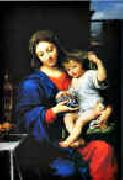 |
Pierre Mignard
|
|
French Baroque Era Painter, 1612-1695
Pierre Mignard (7 novembre 1612 - May 30, 1695), called "Le Romain" to distinguish him from his brother Nicolas, was a French painter. He was born at Troyes, and came of a family of artists; he also needs to be distinguished from his nephew Pierre (1640-1725), often called "Pierre II" or "Le Chevalier".
In 1630 he left the studio of Simon Vouet for Italy, where he spent twenty-two years, and made a reputation which brought him a summons to Paris. Successful with his portrait of the king, and in favour with the court, Mignard pitted himself against Le Brun, declined to enter the Academy of which he was the head, and made himself the centre of opposition to its authority. The history of this struggle is most important, because it was identical, as long as it lasted, with that between the old gilds of France and the new body which Colbert, for political reasons, was determined to support..
Portrait of Louise de Kerouaille, Duchess of Portsmouth. Wikimedia Commons has media related to: Pierre Mignard
Shut out, in spite of the deserved success of his decorations of the cupola of Val de Grace (1664), from any great share in those public works, the control of which was the attribute of the new Academy, Mignard was chiefly active in portraiture. Turenne, Moliere, Bossuet, Maintenon (Louvre), La Valliere, Sevigne, Montespan, Descartes (Castle Howard), all the beauties and celebrities of his day, sat to him. His readiness and skill, his happy instinct for grace of arrangement, atoned for want of originality and real power.
With the death of Le Brun (1690) the situation changed. Mignard deserted his allies, and succeeded to all the posts held by his opponent. These late honours he did not long enjoy. In 1695 he died whilst about to commence work on the cupola of the Invalides. His best compositions have been engraved by Audran, Edelinck, Masson, Poilly and others.
There is a good selection of works by Pierre, Nicolas, and Pierre II in Avignon at the Mus??e Calvet. The Courtauld Institute of Art (London), Harvard University Art Museums, the Hermitage Museum, the Honolulu Academy of Arts, Kunst Indeks Danmark, the Louvre, Mus??e d'art et d'histoire (Geneva), Mus??e des Augustins (Toulouse, France), Mus??e Ingres (Montauban, France), Museo Lombardi (Parma, Italy), the Museum of Fine Arts, Houston, the National Gallery, London, the National Portrait Gallery, London, the North Carolina Museum of Art, the Portland Art Museum and Versailles are among the public collections holding works by Pierre Mignard |
|
 |
Pierre Montallier
|
|
(c. 1643 - 15 October 1697) was a French painter.[1] He died in Paris.
|
|
 |
Pierre-Denis Martin
|
|
(b. ca. Paris 1663-d. Paris 1742) was a French painter, best known for his paintings of royal residences.
He was also known as "Martin le Jeune" ("Martin the Young") or as "Martin des Gobelins" (because he was employed at the Gobelins Manufactory).
|
|
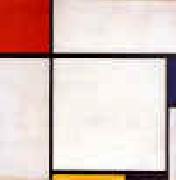 |
Piet Mondrian
|
|
Dutch
1872-1944
Piet Mondrian Location
was a Dutch painter.
He was an important contributor to the De Stijl art movement and group, which was founded by Theo van Doesburg. He evolved a non-representational form which he termed Neo-Plasticism. This consisted of a grid of vertical and horizontal black lines and the use of the three primary colours.
When 47-year-old Piet Mondrian left his artistically conservative native Holland for unfettered Paris for the second and last time in 1919, he set about at once to make his studio a nurturing environment for paintings he had in mind that would increasingly express the principles of Neo-Plasticism about which he had been writing for two years. To hide the studio's structural flaws quickly and inexpensively, he tacked up large rectangular placards, each in a single color or neutral hue. Smaller colored paper squares and rectangles, composed together, accented the walls. Then came an intense period of painting. Then again he addressed the walls, repositioning the colored cutouts, adding to their number, altering the dynamics of color and space, producing new tensions and equilibrium. Before long, he had established a creative schedule in which a period of painting took turns with a period of experimentally regrouping the smaller papers on the walls, a process that directly fed the next period of painting. It was a pattern he followed for the rest of his life, through wartime moves from Paris to London??s Hampstead in 1938 and 1940, across the Atlantic to Manhattan.
At 71 in the fall of 1943, Mondrian moved into his second and final New York studio at 15 East 59th Street, and set about again to create the environment he had learned over the years was most congenial to his modest way of life and most stimulating to his art. He painted the high walls the same off-white he used on his easel and on the seats, tables and storage cases he designed and fashioned meticulously from discarded orange and apple-crates. He glossed the top of a white metal stool in the same brilliant primary red he applied to the cardboard sheath he made for the radio-phonograph that spilled forth his beloved jazz from well-traveled records, Visitors to this last studio seldom saw more than one or two new canvases, but found, often to their astonishment, that eight large compositions of colored bits of paper he had tacked and re-tacked to the walls in ever-changing relationships constituted together an environment that, paradoxically and simultaneously, was both kinetic and serene, stimulating and restful. It was the best space, Mondrian said, that he had ever inhabited. Tragically, he was there for only a few months: he died of pneumonia in February 1944. |
|
 Mondriaan-665953.jpg) |
Pieter Cornelis (Piet) Mondriaan
|
|
(March 7, 1872?CFebruary 1, 1944) was a Dutch painter.
He was an important contributor to the De Stijl art movement and group, which was founded by Theo van Doesburg. He evolved a non-representational form which he termed Neo-Plasticism. |
|
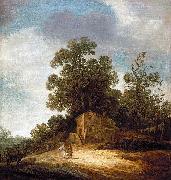 |
Pieter de Molijn
|
|
(6 April 1595 - 23 March 1661) was a Dutch Golden Age painter and engraver born in England.
He was baptized in the Dutch Reformed Austin Friars church in London. Little is known of his early training, but he probably traveled to Italy and in 1616 he became a member of the Haarlem Guild of St. Luke. He was a contemporary of Jacob Pinas. He married Geertuyt Huygen de Bie. During the years 1616-1627 he lived in Delft where he remarried after his first wife died. In the marriage notice, his wife Geertruyt de Roovere is from Amsterdam and he is from Delft.
De Molijn was possibly a student of Esaias van de Velde. He taught several students, including Gerard ter Borch, Jan Coelenbier, Allart van Everdingen, Christian de Hulst, Anthony Molijn, Jan Nose and Jan Wils.De Molijn was known for his landscapes, but he also made genre pieces, marine scenes, portraits, and architectural pieces. This type of oeuvre is typical for the Italian-bound artists of his day, who paid their way as a jack-of-all-trades. De Molijn died in Haarlem on 23 March 1661.
|
|
|
|
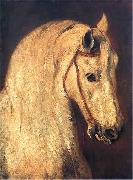 |
Piotr Michalowski
|
|
(July 2, 1800 - June 9, 1855) was a Polish painter of the Romantic period, especially known for his many portraits.
His talent was long underestimated, but he was re-discovered by Pablo Picasso in 1948. When the painter visited Poland, he saw Michałowski's work in the Warsaw National Museum and shouted, "Here, painter!"
The Sukiennice Museum, a division of the National Museum in Krakew, contains a room devoted to Michałowski's work.
|
|
|
|
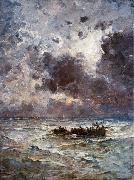 |
Pompeo Mariani
|
|
(Monza, Province of Milan 1857 - Bordighera, Province of Imperia, 1927) was an Italian painter.
The nephew of Mose Bianchi, Mariani abandoned a career in banking to devote himself entirely to painting. His apprenticeship began in 1879 under the guidance of the painter Eleuterio Pagliano, who introduced him to life studies. A trip to Egypt with Uberto DelleOrto in 1881 provided subjects for the works shown at the Brera exhibitions of the next two years. He focused on landscape painting and began to specialise in seascapes in 1883, when he first stayed on the coast of Liguria. The first views of the Zelata area outside Pavia appeared in 1894. His art is characterised by subtle sensitivity in the investigation of the reflection of light on water, captured in different seasons and times of the day to achieve highly atmospheric effects. In was at the beginning of the new century that he began to combine naturalistic landscapes with depictions of the elegant world of high society in fashionable gatherings and cafes. His vast production of landscapes and portraits was regularly presented at the major national and international exhibitions and won numerous official awards.
|
|
 |
Pratt, Matthew
|
|
American Colonial Era Painter, 1734-1805
.American painter. One of ten children of a goldsmith, he was apprenticed at 15 to his uncle, James Claypoole. He spent almost seven years as an apprentice and eight as a painter of portraits and signs for taverns, shops and counting houses. In 1764 he went to England, |
|
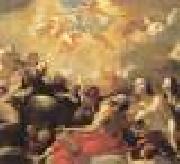 |
PRETI, Mattia
|
|
Italian Baroque Era Painter, 1613-1699
Italian painter and draughtsman. Although he was trained and had his first success as a painter in Rome during the 1630s and 1640s, he is traditionally associated with the Neapolitan school. It was in Naples between 1653 and 1660 that he made his most lasting mark (see fig. 1), contributing to the evolution of the exuberant late Baroque style and providing an important source of inspiration to later generations of painters, notably to Francesco Solimena. From 1661 he was based in Malta, where his most substantial undertaking was the decoration of St John's, Valletta. Preti's mature style is intensely dramatic and unites a Caravaggesque realism and expressive chiaroscuro with the grandeur and theatricality of Venetian High Renaissance painting. |
|
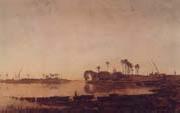 |
Prosper Marilhat
|
|
French Academic Painter, 1811-1847, French painter. He painted his first landscapes and family portraits at Thiers and in the Auvergne before moving to Paris in 1829. After working as the pupil of Camille Roqueplan he was engaged by Baron Karl von H?gel for an expedition to the Near East (1831-3), from which he brought back numerous studies. He visited Greece, Syria, Lebanon and Palestine, stayed in Egypt from October 1831 to May 1833 and returned by way of Rhodes and Corfu. Cairo, the villages of the Delta and Upper Egypt proved to be sources of inspiration for later works. |
|
 |
Quentin Massys
|
|
1464-1530
Flemish
Quentin Massys Galleries
Quentin Matsys, his first name also recorded as Quinten or Kwinten and his last name as Massys, Metsys, or Matsijs (1466 - 1530), was a painter in the Flemish tradition and a founder of the Antwerp school. He was born at Leuven, where he was trained as an ironsmith. Near the front of the Cathedral of Our Lady in Antwerp is a wrought-iron well, known as the "Matsys Well," which according to tradition was made by the painter-to-be.
During the greater part of the 15th century, the centres in which the painters of the Low Countries most congregated were Tournai, Bruges, Ghent and Brussels. Leuven gained prominence toward the close of this period, employing workmen from all of the crafts. Not until the beginning of the 16th century did Antwerp take the lead which it afterward maintained against Bruges, Ghent, Brussels, Mechelen and Leuven. Matsys, as a member of Antwerp's Guild of Saint Luke, was one of its first notable artists.
A legend relates how Matsys, while a smith in Leuven, fell in love with the daughter of a painter; by changing his trade to painting, he hoped that she would love him in return. Less poetic but perhaps more likely is another version of the story: Quentin's father, Josse Matsys, was clockmaker and architect to the municipality of Leuven. The question arose as to which of his sons, Quentin or Josse, should follow in this lucrative business. Josse the son elected to succeed the father. Quentin then took up the study of painting.
We are not told expressly by whom Matsys was taught, but his style seems to have derived from the lessons of Dirk Bouts, who brought to Leuven the influence of Memling and van der Weyden. When Matsys settled at Antwerp at the age of twenty-five, his own style contributed importantly to reviving Flemish art along the lines of van Eyck and van der Weyden.
What characterizes Matsys in particular is a strong religious feeling, an inheritance from earlier schools. This feeling was permeated by a realism which often favored the grotesque. The faces of the boors of Steen or Ostade may well have had predecessors in the pictures of Matsys, though he was not inclined to use them in the same homely way. From the example of van der Weyden comes Matsys' firmness of outline, clear modelling and thorough finish of detail; from the van Eycks and Memling by way of Dirck Bouts, the glowing richness of transparent pigments.
The date of his departure from Leuven is 1491, when he became a master in the guild of painters at Antwerp. His most celebrated picture was executed in 1508 for the joiners' company in the cathedral of his adopted city. Next in importance is the Marys of Scripture round the Virgin and Child, ordered for a chapel in the cathedral of Leuven. Both altarpieces are now in public museums, one at Antwerp and the other at Brussels. They display an earnestness in expression, a minuteness of rendering, and subdued effects of light or shade. Matsys, like the early Flemish painters, lavishes care on jewelry, edgings of garments, and ornament in general.
The Moneylender and his Wife (1514)
Oil on panel, 71 x 68 cm Mus??e du Louvre, ParisNot much given to atmosphere, his paintings sometimes rely on the literalness of caricature: emphasizing the melancholy refinement of saints, the brutal gestures and grimaces of gaolers and executioners. Strenuous effort is devoted to the expression of individual character. A satirical tendency may be seen in the pictures of merchant bankers (Louvre and Windsor), revealing their greed and avarice. His other impulse, dwelling on the feelings of tenderness, may be noted in two replicas of the Virgin and Child at Berlin and Amsterdam, where the ecstatic kiss of the mother seems rather awkward. An expression of acute despair may be seen in a Lucretia in the museum at Vienna. The remarkable glow of the colour in these works, however, makes the Mannerist exaggerations palatable.
But on the whole, the best pictures of Matsys are the quietest. His Virgin and Christ, Ecce Homo and Mater Dolorosa (London and Antwerp) display a serene and dignified mastery, gaining in delicacy and nuance in the works of his maturity. It is believed that he may have known the work of Leonardo da Vinci in the form of prints made and circulated among northern artists.
Matsys had considerable skill as a portrait painter. His Ægidius (Peter Gilles) which drew from Thomas More a eulogy in Latin verse, is but one of many, to which one may add the portrait of Maximilian of Austria in the gallery of Amsterdam. In this branch of his practice, Matsys was greatly influenced by his contemporaries Lucas van Leyden and Jan Mabuse.
In his rendering of polished detail, he may lack the subtle modelling of Holbein and D??rer. There is reason, however, to think him well acquainted with these German masters. He probably met Holbein more than once on his way to England. D??rer visited his house at Antwerp in 1520. Matsys also became the guardian of Joachim Patinir's children after the death of that painter, who is believed to have worked on some of the landscapes in Matsys' pictures.
Matsys died at Antwerp in 1530. That rigor of religious feeling, which could be said to have slumbered in him, was eventually fatal to some of his relatives. His sister Catherine and her husband suffered at Leuven in 1543 for what was then the capital offence of reading the Bible: he being decapitated, she buried alive in the square before the cathedral.
His works include A Portrait of an Elderly Man (1513), The Money Changer and His Wife (1514), and The Ugly Duchess (1515).
The Ugly Duchess is perhaps the best-known of his works. It served as a basis for John Tenniel's depiction of the Duchess in Alice's Adventures in Wonderland. It is likely a depiction of a real person with Paget's disease[1], though it is sometimes said to be a portrait of Margaret, countess of Tyrol, also known as Margarete Maultasch ("Satchel-mouth").
Quentin's son, Jan Matsys, inherited the art but not the skill of his father. The earliest of his works, a St Jerome dated 1537, in the gallery of Vienna, as well as the latest, a Healing of Tobias of 1564, in the museum of Antwerp, are evidence of his tendency to substitute imitation for originality. Another son, Cornelis Matsys, was also a painter. Jan's son, Quentin Metsys the Younger, was an artist of the Tudor court, and painted the Seive Portrait of Elizabeth I of England. |
|
 |
Quentin Matsys
|
|
Flemish Northern Renaissance Painter, ca.1465-1530,Flemish painter. After studying in Louvain, he moved to Antwerp by 1491, remaining in that city throughout his life. Influences of Italian art, especially of Leonardo da Vinci, may be seen in his work, particularly in the delicate modeling, the subtle nuances of tone, and in the adoption of Leonardo's grotesque head studies for such pictures as The Old Man (Jacquemart-Andre Mus., Paris) and Ugly Duchess (National Gall., London). Massys sought inspiration also in works of earlier Flemish artists, especially of Jan van Eyck. The combined Flemish and Italian influences aided Massys in evolving a calm and measured style, with solid figures and soft textures. He developed a type of portraiture in which the sitter was placed against an appropriate background, as in his painting of St. Erasmus surrounded by books and papers (National Gall., Rome). There are religious subjects and portraits by Massys in the museums of Munich, Brussels, Antwerp, Chicago, and Philadelphia. Quentin's son, Jan Massys, c.1509?C1575, painted satirical and later more elegant works under French influence. Judith (Mus. of Fine Arts, Boston) is characteristic. Another son, Cornelis Massys, d. after 1560, was a landscape painter and engraver. |
|
 |
Raimundo de Madrazo y Garreta
|
|
1841-1920
Spanish
Son of Federico de Madrazo y Kentz. Because of his ability and training with his father, Federico, in the Real Academia de S Fernando in Madrid and with Leon Cogniet in Paris, he seemed destined to continue the family tradition of academic painting. However, due to the influence of the Belgian Alfred Stevens, of his brother-in-law, Mariano Jose Bernardo Fortuny y Marsal, and the Parisian environment, he exchanged dry historical painting for the preciousness of the tableautin, the small, intimate genre painting. He lived in Paris and New York and became so remote from Spanish artistic life that he and Fortuny y Marsal were the only Spanish artists not to participate in any national exhibition, and because of this the Spanish state never directly acquired their works. In 1882, with Giuseppe De Nittis, Stevens and the gallery owner Georges Petit, he co-founded the Exposition Internationale de Peinture, designed to promote foreign artists in Paris. Madrazo Garreta most characteristic works are the female portrait and the witty and elegant genre painting, with soft, delicate tones and suggestive poses. The influence of the Rococo and of Japanese art is reflected in his painting, which expresses an exquisite aristocratic or bourgeois ideal, the illusion of a refined, sensual and superficial life. Consequently, his works are also described as representing the Parisian seraglio. American collectors paid high prices for his paintings, for example Alexander Turney Stewart bought Lady with a Parrot; Carnival Festival (1878) was purchased by L. Wolfe; and Girls at the Window (1875) was bought by J. W. Vanderbilt, the last two now being in the Metropolitan Museum of Art, New York. His portraits were better received in Spain although because of collectors such as Ramen de Errazu (d 1909), the Museo del Prado has a good number of his paintings (e.g. After the Bath). |
|
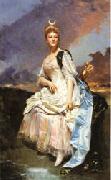 |
Raimundo de Madrazo y Garreta
|
|
Spanish realist Painter , 1841-1920
Son of Federico de Madrazo y K?ntz. Because of his ability and training with his father, Federico, in the Real Academia de S Fernando in Madrid and with L?on Cogniet in Paris, he seemed destined to continue the family tradition of academic painting. However, due to the influence of the Belgian Alfred Stevens, of his brother-in-law, Mariano Jos? Bernardo Fortuny y Marsal, and the Parisian environment, he exchanged dry historical painting (e.g. Arrival in Spain of the Body of the Apostle St James, 1858, and Ataulfo, 1860) for the preciousness of the tableautin, the small, intimate genre painting. He lived in Paris and New York and became so remote from Spanish artistic life that he and Fortuny y Marsal were the only Spanish artists not to participate in any national exhibition, and because of this the Spanish state never directly acquired their works. In 1882, with Giuseppe De Nittis, Stevens and the gallery owner Georges Petit, he co-founded the Exposition Internationale de Peinture, designed to promote foreign artists in Paris. Madrazo Garreta's most characteristic works are the female portrait and the witty and elegant genre painting, with soft, delicate tones and suggestive poses. The influence of the Rococo and of Japanese art is reflected in his painting, which expresses an exquisite aristocratic or bourgeois ideal, the illusion of a refined, sensual and superficial life. Consequently, |
|
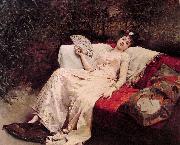 |
Raimundo Madrazo
|
|
(1841, Rome - 1920) was a Spanish realist painter.
He studied painting under his father, Federico de Madrazo, and at the School of the Beaux Arts in Madrid. After 1860 he lived mostly in Paris, where he studied under L??on Cogniet. His remarkable technical ability made him a highly successful portrait painter in a Salon style.
|
|
 |
Ramon marti alsina
|
|
Spanish , 1826-1894
He studied in Paris in successive stages over which he came to know the work of Courbet, the French Realists and the Barbizon school. In the end he even adapted to Impressionism. He is considered the best representative of Spanish Realism.. |
|
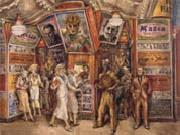 |
Reginald Marsh
|
|
American Social Realist Painter, 1898-1954,American painter, printmaker and illustrator. He returned from France to the USA with his American parents, Fred Dana Marsh (1872-1961) and Alice Marsh, who were also artists, in 1900. In 1920 he graduated from Yale University, New Haven, CT, where he had been art editor and cartoonist for the Yale Record. He moved to New York and became staff artist for Vanity Fair and the New York Daily News. By 1923 he had begun painting scenes of street life in New York in oil and watercolour. His first one-man show was held at the Whitney Studio Club in 1924. In 1925 he joined the New Yorker, to which he contributed regularly until 1931. |
|
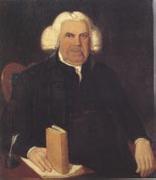 |
Reuben Moulthrop
|
|
American portrait, miniature, wax sculptor
b.1763-d.1814
American painter. As proprietor of a waxworks museum and travelling waxworks exhibition, he was interested in modelling in wax in his early years. While moving around his native state, he was exposed to several artistic influences, beginning with Winthrop Chandler. His earliest portraits seem to date from about 1788, when he completed Mr and Mrs Samuel Hathaway (1788; New Haven, CT, Colony Hist. Soc. Mus.). Its dark, heavy outlines, its flatness and almost geometric forms derive from Chandler. The quality of Moulthrop's paintings was extremely uneven; many of the best of the surviving body of about 50 works date from around 1800. The Rev. Thomas Robbins which depicts the sitter's direct gaze and contains more detail than the earlier portraits, shows the artist at his most accomplished. In the last years of his brief career he appears to have been influenced by William Jennys and John Durand, |
|
|
|
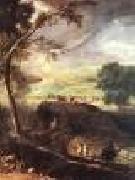 |
RICCI, Marco
|
|
Italian Painter, 1676-1730
Painter, printmaker and stage designer, nephew of (1) Sebastiano Ricci. He probably began his career in Venice in the late 1690s as his uncle's pupil, concentrating on history paintings (untraced). Having murdered a gondolier in a tavern brawl, he fled to Split in Dalmatia, where he remained for four years and was apprenticed to a landscape painter (Temanza, 1738). Once back in Venice (c. 1700) he put this training to use in painting theatrical scenery. Little is known about his early development, and it remains difficult to establish a chronology for his work. A group of restless, romantic landscapes (examples, Leeds, Temple Newsam House; Padua, Mus. Civ.), painted with lively, free strokes and formerly thought to represent his early period, have now been convincingly attributed (Moretti) to Antonio Marini (1668-1725). His earliest dated works, a tempera painting, View with Classical Ruins (1702; priv. col.), and a Landscape with Fishermen (1703; ex-Kupferstichkab., Berlin; untraced), are serene and classical, close in style to tempera paintings generally dated 1710-30. This suggests that Ricci's style did not develop much, and that strong classicizing tendencies, |
|
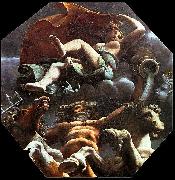 |
Rinaldo Mantovano
|
|
Rinaldo Mantovano ( fl Mantua, c . 1527-39). Italian painter. According to Vasari, he was the best pupil of Giulio Romano. |
|
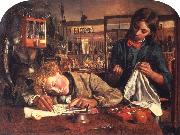 |
Robert Braithwaite Martineau
|
|
English genre and portrait Painter, 1826-1869
was an English painter. He first trained as a lawyer and later entered the Royal Academy where he was awarded a silver medal. He studied under Pre-Raphaelite artist William Holman Hunt and once shared a studio with him. He died at the age of 43. He married Maria Wheeler and had two children with her. His most famous painting, "The Last Day in the Old Home" portrays a man who has brought ruin upon his family and can be seen at the Tate Gallery in London. Other paintings were bequeathed to the Ashmolean Museum in Oxford and Liverpool Art Gallery by his daughter Helen. Other less well known paintings include "Kit's First Writing Lesson" and "Picciola". |
|
|
|
 |
Robert Crannell Minor
|
|
(1839-1904), American artist, was born in New York City on 30 April 1839, and received his art training in Paris under Diaz, and in Antwerp under Joseph Van Luppen. His paintings are characteristic of the Barbizon school, and he was particularly happy in his sunset and twilight effects; but it was only within a few years of his death that he began to have a vogue among collectors. In 1897 he was elected a member of the National Academy of Design, New York. After 1900 he lived at Waterford, Connecticut, where he died on 4 August 1904. |
|
|
|
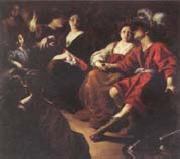 |
Rutilio Manetti
|
|
Italian Baroque Era Painter ,
1571 - 1639
was an Italian painter of late-Mannerism or proto-Baroque, active mainly in Siena. He was influenced and/or taught by the local artists Francesco Vanni and Ventura Salimbeni. He is known to have collaborated with Raffaele Vanni, the son of Francesco. He is known for the following works in Siena or nearby towns: Story of St Catherine and Pope Gregory (1597; Palazzo Pubblico), Baptism of Christ (1600; San Giovannino in Pantaneto); a fresco cycle of the Story of St Roch (1605-1610; San Rocco alla Lupa), Pope Alexander I freed from prison by an Angel from San Giovanni Battista in Sant'Ansano in Greti; a Temptation of Saint Anthony (1620, Sant'Agostino), a Death of Blessed Antonino Patrizi (Monticiano, 1616), a Blessed Domenico dal Pozzo at the table now in Certosa of Florence, a Birth of Virgin (1625, Church of Santa Maria dei Servi), and a painting (1628, Church of San Domenico). He painted a remarkable Allegory of the four seasons and a Parable of the blind men, now in private collections. He also contributed to the Casino Mediceo His style moved from one derived from Barocci to a more Caravaggesque manner after the first decade of the 1600s. |
|
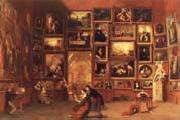 |
Samuel FB Morse
|
|
1791-1872,American painter and inventor. The son of a Calvinist minister, he began amateur sketching while a student at Yale College, New Haven, CT. After graduating in 1810, he returned to Charlestown, MA, to paint family portraits. In Boston in the same year he met Washington Allston, recently returned from Italy, under whose tutelage he executed his first history painting, the Landing of the Pilgrims at Plymouth (c. 1810-11; Boston, MA, Pub. Lib.). He joined Allston on his trip to London in 1811, enrolled in the Royal Academy Schools and also studied privately with Allston and Benjamin West. Morse Dying Hercules (1812-13; New Haven, CT, Yale U. A.G.), based on the pose and musculature of the Laokoon (Rome, Vatican, Mus. Pio-Clementino) and the theory evident in Allston Dead Man Restored to Life by Touching the Bones of the Prophet Elisha (1811-14; Philadelphia, PA Acad. F.A.), was critically acclaimed when exhibited at the Royal Academy and is indicative of Morse academic interests. After two trips in 1813 and 1814 to Bristol, where he painted a number of portraits and small subject pieces, Morse ended his period in England with another mythological history painting, the Judgement of Jupiter (1814-15; New Haven, CT, Yale U. A.G.). |
|
 |
Samuel Finley Breese Morse
|
|
1791-1872
Samuel F.B. Morse was born on April 27, 1791 in Charlestown, Massachusetts, the first child of geographer and Pastor Jedidiah Morse (1761-1826) and Elizabeth Ann Breese (1766-1828). Jedidiah was a great preacher of the Calvinist faith and supporter of the American Federalist party. He not only saw it as a great preserver of Puritan traditions (strict observance of the Sabbath), but believed in its idea of an alliance with English in regards to a strong central government. Jedidiah strongly believed in education within a Federalist framework alongside the instillation of Calvinist virtues, morals and prayers for his son. After attending Phillips Academy in Andover, Massachusetts, Samuel Morse went on to Yale College to receive instruction in the subjects of religious philosophy, mathematics and science of horses. While at Yale, he attended lectures on electricity from Benjamin Silliman and Jeremiah Day. He earned money by painting. In 1810, he graduated from Yale.
Morse's Calvinist beliefs are evident in his painting the Landing of the Pilgrims, through the depiction of simplistic clothing as well as the austere facial features. This image captured the psychology of the Federalists; Calvinists from England brought to the United States ideas of religion and government thus forever linking the two countries. More importantly, this particular work attracted the attention of the famous artist, Washington Allston. Allston wanted Morse to accompany him to England to meet the artist Benjamin West. An agreement for a three- year stay was made with Jedidah, and young Morse set sail with Allston aboard the Lydia on July 15, 1811 (1).
Upon his arrival in England, Morse diligently worked at perfecting painting techniques under the watchful eye of Allston; by the end of 1811, he gained admittance to the Royal Academy. At the Academy, he fell in love with the Neo-classical art of the Renaissance and paid close attention to Michelangelo and Raphael. After observing and practicing life drawing and absorbing its anatomical demands, the young artist successfully produced his masterpiece, the Dying Hercules.
To some, the Dying Hercules seemed to represent a political statement against the British and also the American Federalists. The muscles apparently symbolized the strength of the young and vibrant United States versus the British and British-American supporters. During Morse??s time in Britain the Americans and English were engaged in the War of 1812 and division existed within United States society over loyalties. Anti-Federalists Americans aligned themselves with the French, abhorred the British, and believed a strong central government to be inherently dangerous to democracy.(3) As the war raged on, his letters to his parents became more anti-Federalist in their tones. In one such letter Morse said, "I assert that the Federalists in the Northern States have done more injury to their country by their violent opposition measures than a French alliance could. Their proceedings are copied into the English papers, read before Parliament, and circulated through their country, and what do they say of them... they call them (Federalists) cowards, a base set, say they are traitors to their country and ought to be hanged like traitors." |
|
|
|
|
|
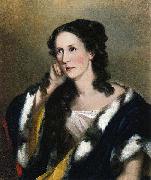 |
Sarah Miriam Peale
|
|
(Philadelphia, Pennsylvania, May 19, 1800 - February 4, 1885, Philadelphia) was an American portrait painter, one of the notable family of artists descended from the miniaturist and still-life painter James Peale, who was her father. She is noted as a portrait painter, mainly of politicians and military figures. Lafayette sat for her four times.
Sarah was James Peale's youngest daughter and was trained by her father, and uncle Charles Willson Peale. She served as a studio assistant to her father. Her first public works date from 1816 with subjects such as flowers and still-life but soon turned to portraiture, In 1818, she spent three months with Rembrandt Peale, her cousin, in Baltimore, and again in 1820 and 1822. He influenced her painting style and subject matter. For 25 years, she painted in Baltimore (1822-47) and, intermittently, in Washington, D.C.
She was accepted to the Pennsylvania Academy of Fine Arts in 1824 along with her sister Anna Claypoole Peale, the first women to achieve this distinction. Over 100 commissioned portrait paintings are known from her time in Baltimore and she was the most prolific artist in the city during that era. Her subjects were wealthy Baltimore residents and politicians from Washington DC. |
|
|
|
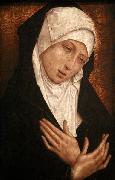 |
Simon Marmion
|
|
(born c. 1425 at Amiens, France, died 24 or 25 December 1489, Valenciennes) was a French or Burgundian Early Netherlandish painter of panels and illuminated manuscripts. Marmion lived and worked in what is now France but for most of his lifetime was part of the Duchy of Burgundy in the Southern Netherlands.
Like many painters of his era, Marmion came from a family of artists, and both his father, Jean, and his brother Mille were painters. Marmion is recorded as working at Amiens between 1449 to 1454, and then at Valenciennes from 1458 until his death. He was patronized by Philip the Good, the Duke of Burgundy from 1454 when he was one of several artists called to Lille to work on the decorations for the Feast of the Pheasant. He was employed by several members of the ducal family, including Charles the Bold and Margaret of York. He was called "the prince of illuminators" by a near contemporary. Three years after his death his widow, Jeanne de Quaroube, married his pupil, the painter Jan Provoost, who on her death inherited the considerable Marmion estate.
Although best known for his illuminated manuscripts, Marmion also produced portraits and other paintings, altarpieces, and decorative work. A famous double-sided altarpiece with several Scenes from the life of St Bertin is in the Gemäldegalerie, Berlin (with two sections in the National Gallery (London). There is a Mass of Saint Gregory in Toronto, and a Lamentation of Christ in the Metropolitan Museum of Art,three works in Philadelphia, and several others elsewhere. Stylistically he lies between his French and Flemish contemporaries, with a Flemish innovation in composition and landscape. His perspective is usually technically sound, but the proportions of his figures are often awkward, and their poses rather stiff.
|
|
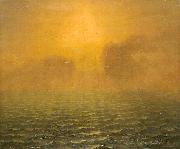 |
Simon Mathurin Lantara
|
|
(24 March 1729 - 22 December 1778) was a French landscape painter.
He was born at Oncy. His father was a weaver, and he himself began life as a herdboy; but, having attracted the notice of Gille de Reumont, a son of his master, he was placed under a painter at Versailles. Endowed with great facility and real talent, his powers found ready recognition; but he found the constraint of a regular life and the society of educated people unbearably tiresome; and as long as the proceeds of the last sale lasted he lived careless of the future in the company of obscure workmen. Rich amateurs more than once attracted him to their houses, only to find that in ease and high living Lantara could produce nothing. He died in Paris in 1778.
His works, now much prized, are not numerous; the Louvre has one landscape, Morning, signed and dated 1761. Émile Bernard, Joseph Vernet, and others are said to have added figures to his landscapes and sea-pieces. Engravings after Lantara will be found in the works of Lebas, Piquenot, Duret, Mouchy and others. In 1809 a comedy called Lantara, or the Painter in the Pothouse, was brought out at the Vaudeville with great success.
|
|
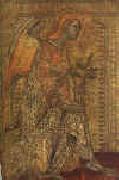 |
Simone Martini
|
|
1283-1344
Italian
Simone Martini Locations
He was a major figure in the development of early Italian painting and greatly influenced the development of the International Gothic style. It is thought that Martini was a pupil of Duccio di Buoninsegna, the leading Sienese painter of his time. His brother-in-law was the artist Lippo Memmi. Very little documentation survives regarding Simone's life, and many attributions are debated by art historians. Simone Martini died while in the service of the Papal court at Avignon in 1344.
Simone was doubtlessly apprenticed from an early age, as would have been the normal practice. Among his first documented works is the Maest?? of 1315 in the Palazzo Pubblico in Siena. A copy of the work, executed shortly thereafter by Lippo Memmi in San Gimignano, testifies to the enduring influence Simone's prototypes would have on other artists throughout the fourteenth century. Perpetuating the Sienese tradition, Simone's style contrasted with the sobriety and monumentality of Florentine art, and is noted for its soft, stylized, decorative features, sinuosity of line, and unsurpassed courtly elegance. Simone's art owes much to French manuscript illumination and ivory carving: examples of such art were brought to Siena in the fourteenth century by means of the Via Francigena, a main pilgrimage and trade route from Northern Europe to Rome.
Simone's major works include the Maest?? (1315) in the Palazzo Pubblico in Siena, St Louis of Toulouse Crowning the King at the Museo di Capodimonte in Naples (1317), the S. Caterina Polyptych in Pisa (1319) and the Annunciation and two Saints at the Uffizi in Florence (1333), as well as frescoes in the Chapel of St. Martin in the lower church of the Basilica of San Francesco d'Assisi. Francis Petrarch became friend with Simone while in Avignon, and two of his sonnets make reference to a portrait of Laura de Noves he supposedly painted for the poet.
|
|
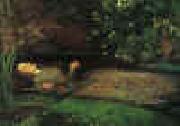 |
Sir John Everett Millais
|
|
British 1829-1896 Sir John Everett Millais Galleries After his marriage, Millais began to paint in a broader style, which was condemned by Ruskin as "a catastrophe". It has been argued that this change of style resulted from Millais' need to increase his output to support his growing family. Unsympathetic critics such as William Morris accused him of "selling out" to achieve popularity and wealth. His admirers, in contrast, pointed to the artist's connections with Whistler and Albert Moore, and influence on John Singer Sargent. Millais himself argued that as he grew more confident as an artist, he could paint with greater boldness. In his article "Thoughts on our art of Today" (1888) he recommended Vel??zquez and Rembrandt as models for artists to follow. The Two Princes Edward and Richard in the Tower (1878) The Boyhood of Raleigh (1871)Paintings such as The Eve of St. Agnes and The Somnambulist clearly show an ongoing dialogue between the artist and Whistler, whose work Millais strongly supported. Other paintings of the late 1850s and 1860s can be interpreted as anticipating aspects of the Aesthetic Movement. Many deploy broad blocks of harmoniously arranged colour and are symbolic rather than narratival. Later works, from the 1870s onwards demonstrate Millais' reverence for old masters such as Joshua Reynolds and Vel??zquez. Many of these paintings were of an historical theme and were further examples of Millais' talent. Notable among these are The Two Princes Edward and Richard in the Tower (1878) depicting the Princes in the Tower, The Northwest Passage (1874) and the Boyhood of Raleigh (1871). Such paintings indicate Millais' interest in subjects connected to Britain's history and expanding empire. His last project was to be a painting depicting a white hunter lying dead in the African veldt, his body contemplated by two indifferent Africans. This fascination with wild and bleak locations is also evident in his many landscape paintings of this period, which usually depict difficult or dangerous terrain. The first of these, Chill October (1870) was painted in Perth, near his wife's family home. Many others were painted elsewhere in Perthshire, near Dunkeld and Birnam, where Millais rented grand houses each autumn in order to hunt and fish. Millais also achieved great popularity with his paintings of children, notably Bubbles (1886) ?C famous, or perhaps notorious, for being used in the advertising of Pears soap ?C and Cherry Ripe. |
|
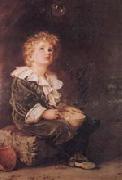 |
Sir John Everett Millais
|
|
English Pre-Raphaelite Painter, 1829-1896
Millais showed a prodigious natural facility for drawing, and his parents groomed him from an early age to become an artist. His father was a man of independent means from an old Jersey family. He spent his childhood in Southampton (where his mother's family were prosperous saddlers), Jersey and Dinan in Brittany, before going to London in 1838. After a brief period at Henry Sass's private art school, he was accepted into the Royal Academy Schools in 1840, its youngest-ever student. He won a silver medal there in 1843 for his drawing from the Antique, made his d?but at the Royal Academy exhibition in 1846 with the accomplished though conventional history painting Pizarro Seizing the Inca of Peru (London, V&A) and won a gold medal in 1847 for the Tribe of Benjamin Seizing the Daughters of Shiloh (priv. col., sale cat., London, Sotheby's, 21 Nov 1973, lot 44), |
|
|
|
|
|
|
|
 |
STANZIONE, Massimo
|
|
Italian Baroque Era Painter, 1585-1656
Italian painter. Primarily a painter of altarpieces and frescoes, his large production and vast following of students and imitators made him perhaps the leading Neapolitan painter in the first half of the 17th century. He was known as the great rival of Jusepe de Ribera, and for most of the 1630s and 1640s he and Ribera dominated painting in Naples. Stanzione's rich colour and idealized naturalism, for which he was called 'il Guido Reni napoletano', definitively influenced numerous local artists and remained discernible in the earliest works (1670s) of Francesco Solimena. Only a few portraits and mythological paintings by Stanzione are known, |
|
|
|
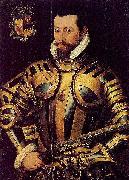 |
Steven van der Meulen
|
|
(b. eAntwerp - d. London, e1563-64) was a Dutch artist active c. 1543-1564. He gained prominence in England in the first decade of the reign of Elizabeth I as one of many Flemish artists active at the Tudor court. He is best known for the "Barrington Park" portrait type of Elizabeth I and for three-quarter length portraits of members of the English court in the first half of the 1560s. A recently discovered will indicates that he died in London between October 1563 and January 1564.
|
|
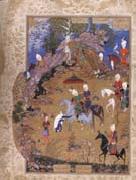 |
Sultan Muhammad
|
|
Persian Painter, active ca.1505-1550
Persian illustrator. He was apparently a native of Tabriz and spent most of his life there. Contemporary sources suggest that he was at the height of his creative powers in the 1520s and 1530s when he was one of the leading painters in the employ of the Safavid shah Tahmasp. Sultan-Muhammad's documented paintings include contributions to a monumental copy (dispersed, ex-Houghton priv. col.) of Firdawsi's Shahnama ('Book of kings') made for Tahmasp between c. 1524 and c. 1529 and paintings from a copy (divided, New York, Met. and Cambridge, MA, Sackler Mus.) of Hafiz's Divan (collected poems), probably executed between 1531 and 1533. Sultan-Muhammad's paintings for these manuscripts demonstrate how the tradition of western Iranian painting as practised in Tabriz, Shiraz and other centres during the 15th century continued to be significant at the Safavid court . |
|
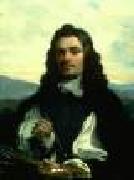 |
SWEERTS, Michiel
|
|
Flemish Baroque Era Painter, ca.1618-1664
Flemish painter, active in Italy, Syria and India. He arrived in Rome in the mid-1640s, perhaps in circumstances similar to those depicted in his painting The Landing (Paris, Louvre). In 1646 he was registered as living in the Via Margutta in the parish of S Maria del Popolo, where documents indicate that he continued to reside until 1651, together with other Flemish Catholics like himself. In 1647 he attended a meeting of the Accademia di S Luca, not as an academician but simply as an associate. The following year he was visited by the Dutch poet Matthijs van de Merwede (1625-?1677), who later recalled the extremely poor welcome he received from the artist. On 1 June 1651 Sweerts was employed by the Antwerp merchant Jan Deutz to represent him at the Papal Customs to collect seven pieces of woollen cloth from Leiden. Sweerts's relationship with the Deutz family was always close: he painted portraits of Jeronimus Deutz (Amsterdam, Rijksmus.) and Balthasar Deutz and a series of the Seven Acts of Mercy for the family; some scholars have identified this series with the cycle of paintings divided between the Rijksmuseum, Amsterdam, the Wadsworth Atheneum, Hartford, CT, and two private collections |
|
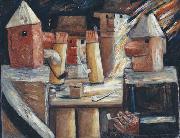 |
Tadeusz Makowski
|
|
(21 January 1882 - 1 November 1932) was a prominent Polish painter active in France for most of his life. He was born in Oświęcim. Makowski attended the Academy of Fine Arts in Krakew. He studied under Jan Stanisławski and Jezef Mehoffer. In 1909, he departed for Paris. Makowski started off as a landscape painter but then shifted towards Post-Impressionism and Cubism. However, he is arguably most famous for his rural landscape paintings. He met Pablo Picasso,who was his good friend.
|
|
|
|
|

